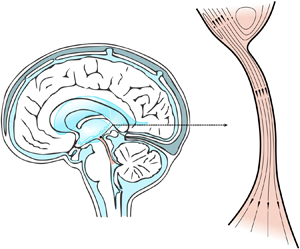Article contents
A model for the oscillatory flow in the cerebral aqueduct
Published online by Cambridge University Press: 20 July 2020
Abstract

This paper addresses the pulsating motion of cerebrospinal fluid in the aqueduct of Sylvius, a slender canal connecting the third and fourth ventricles of the brain. Specific attention is given to the relation between the instantaneous values of the flow rate and the interventricular pressure difference, needed in clinical applications to enable indirect evaluations of the latter from direct magnetic resonance measurements of the former. An order of magnitude analysis accounting for the slenderness of the canal is used in simplifying the flow description. The boundary layer approximation is found to be applicable in the slender canal, where the oscillating flow is characterized by stroke lengths comparable to the canal length and periods comparable to the transverse diffusion time. By way of contrast, the flow in the non-slender opening regions connecting the aqueduct with the two ventricles is found to be inviscid and quasi-steady in the first approximation. The resulting simplified description is validated by comparison with results of direct numerical simulations. The model is used to investigate the relation between the interventricular pressure and the stroke length, in parametric ranges of interest in clinical applications.
JFM classification
- Type
- JFM Rapids
- Information
- Copyright
- © The Author(s), 2020. Published by Cambridge University Press
References
REFERENCES
- 12
- Cited by


